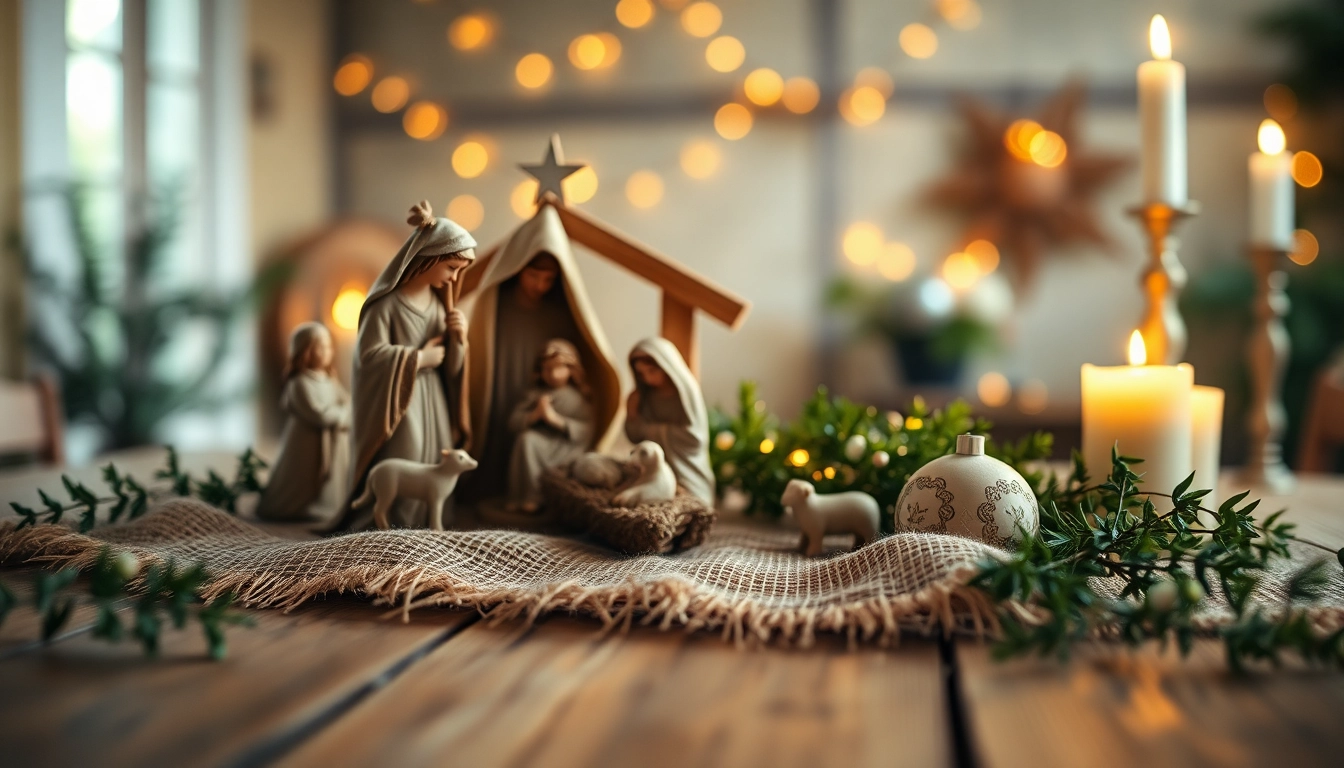Understanding the Essence of Nativity Sets
What Are Nativity Sets?
Nativity sets are three-dimensional depictions of the birth of Jesus Christ, designed to help celebrate the Christmas season. Traditionally, these sets contain figures of the Holy Family, which includes the Virgin Mary, Joseph, and the newborn Jesus, alongside a host of other figures such as angels, shepherds, and animals. While originally crafted from wood or clay, modern nativity sets are made from a wide array of materials, including plastic, resin, and ceramic. Each nativity set is often intricately detailed, reflecting various levels of craftsmanship, and serves both a decorative and a spiritual purpose within many households.
The Symbolism Behind Nativity Scenes
At their core, nativity sets are steeped in symbolism. The figure of Jesus symbolizes the hope and promise of salvation, while Mary and Joseph represent parental care and devotion. The manger setting, with its humble beginnings, signifies simplicity and humility. Each character within the nativity scene holds profound meaning, and together, they tell the story of the Nativity—a narrative central to Christian faith and tradition. The inclusion of animals serves both to accentuate the rural setting of Christ’s birth and to integrate nature into the celebration of his divine arrival.
Types of Nativity Sets Available Today
Today, nativity sets come in a variety of styles and themes, allowing individuals to choose one that resonates with their personal preferences. Some popular types include:
- Traditional Nativity Sets: Often crafted from high-quality materials like porcelain or wood, these sets reflect classic designs and artistry.
- Outdoor Nativity Displays: Made from durable materials suitable for outdoor use, these larger-than-life displays bring the nativity scene into the front yards of many homes.
- Miniature Nativity Sets: Perfect for limited spaces, these small figurines can be displayed on tablets or desks, still telling the story of Christmas in a compact format.
- DIY and Personalized Nativity Sets: Many families opt to create their own nativity sets using various materials, adding a personal touch to their displays.
- Nativity Sets from Different Cultures: These sets reflect distinct cultural interpretations of the nativity story, often including local customs and characters.
Choosing the Perfect Nativity Set for Your Home
Factors to Consider Before Buying Nativity Sets
When selecting a nativity set for your home, there are several factors to consider:
- Size: Consider the space where you plan to display the nativity set. Larger sets may work well for spacious living rooms, while petite models are better suited for smaller areas.
- Material: The selection of material affects both the aesthetics and durability of the nativity set. Choose a material that aligns with your lifestyle—for instance, families with young children might prefer sturdier plastic models.
- Artistic Style: Look for a style that resonates with you, whether it’s traditional artistry reminiscent of classic tales, or a more modern interpretation.
- Budget: Nativity sets range from affordable options to high-end collectibles. Establish your budget beforehand to narrow down your choices effectively.
Where to Find Quality Nativity Sets
Quality nativity sets can be found at various locations, including local craft stores, religious shops, and online retailers. Reputable online platforms like Nativity sets marketplaces offer a diverse selection, often featuring unique pieces from artisans worldwide. Thrift stores and garage sales can also yield hidden gems for those willing to explore.
Personalizing Your Nativity Display
Many families find joy in customizing their nativity displays. Personalization can include adding figurines that represent family members, using heirloom pieces from previous generations, or creating DIY components to supplement the traditional set. You could also incorporate thematic elements such as seasonal decorations, ensuring your display evolves each year to reflect your family’s changing style and tastes.
Caring for Your Nativity Sets
Proper Storage Tips for Nativity Figures
To preserve your nativity set for years to come, proper storage is essential. Always clean and dry each figure before storing them away, as moisture can lead to mold growth. Use acid-free tissue paper for wrapping, and store figures in a sturdy box to protect them from dust and accidental damage. Label boxes clearly so that you can easily find your nativity collection each holiday season.
Cleaning and Maintaining Your Nativity Sets
Regular maintenance of your nativity set is crucial for keeping it looking its best. Depending on the material:
- For ceramic or porcelain figures, use a soft, damp cloth to gently wipe surfaces, avoiding any abrasive cleaners that could scratch the finish.
- Plastic nativity sets can be washed with mild soap and water; make sure to rinse thoroughly before air-drying.
- Wooden figures may benefit from occasional polishing with a dust-free cloth, and it’s wise to keep them away from direct sunlight to prevent fading.
Repairing Damaged Pieces: A How-To Guide
Over time, wear and tear may cause damage to nativity figures. If you find yourself needing to repair a piece, consider the following steps:
- Identify the Damage: Whether it’s a broken arm or chipped paint, assess what needs fixing.
- Gather Supplies: Depending on the type of material, you may need glue, paint, or touch-up markers.
- Reattach Broken Pieces: For minor breaks, use high-quality adhesive specifically designed for ceramics or plastics.
- Touch Up Paint: If your figures require repainting, use acrylic paint to match the original color. Test paint on a hidden area for an accurate match.
Creating Your Own Nativity Scene
DIY Nativity Sets: A Fun Family Project
Creating your own nativity set can be a delightful and educational family project. Gather your family and select materials—options can include clay, fabric, or even recycled items. Engage everyone in the crafting process by assigning roles, whether it’s sculpting figures, painting, or assembling a backdrop. This collaborative effort not only promotes creativity but also builds lasting memories that can be cherished for generations.
Incorporating Unique Materials into Your Nativity Design
To make your nativity scene stand out, consider integrating unique materials that resonate with your family’s culture or interests. For example, you might use driftwood for stable structures, fabric scraps for traditional garb, or even LEGO pieces for a modern twist. Such choices allow you to express personal sentiments, making your nativity scene a distinctive reflection of your family’s values and traditions.
Community Involvement: Organizing Nativity Displays
Engaging your community through organized nativity displays can foster a shared spirit during the holiday season. Visit local community boards or social media groups to gauge interest. From church gatherings to public parks, there are numerous spaces for collaborative displays. Offer family nights where children can help paint, create props, or enact scenes, reinforcing community bonds while celebrating the meaning of Christmas.
The Cultural Significance of Nativity Sets Worldwide
How Different Cultures Celebrate with Nativity Scenes
The depiction of nativity scenes varies significantly across cultures, with each version reflecting local customs, artistry, and beliefs. For example, in Mexico, the tradition of “Las Posadas” includes outdoor nativity recreations, emphasizing the search for shelter by Mary and Joseph. In Italy, the “Presepe” often includes a vibrant array of characters from local life, depicting the rich tapestry of Italian culture intertwined with the nativity story.
The Evolution of Nativity Sets Through History
Historically, nativity sets have evolved from simple drawn images to elaborate, handcrafted scenes. In the Middle Ages, the nativity began to be depicted using sculpture and paint in churches, making it accessible to the public. By the 18th century, nativity sets became a household item in Europe, evolving further with advancements in production techniques, including mass manufacturing in the 20th century. Today, nativity sets vary widely in design, reflecting an expansive spectrum of tastes and artistic interpretations.
Impact of Nativity Sets on Modern Christmas Celebrations
Modern Christmas celebrations are often incomplete without the presence of nativity sets. For families, these decorations transcend mere ornamentation; they are teaching tools that help pass down religious stories and traditions. Church communities also utilize nativity displays as focal points for worship, reflecting the spiritual significance of Christ’s birth. Overall, nativity sets not only celebrate religious history but also serve as a bridge between generations, fostering connections among family and community members during the holiday season.



